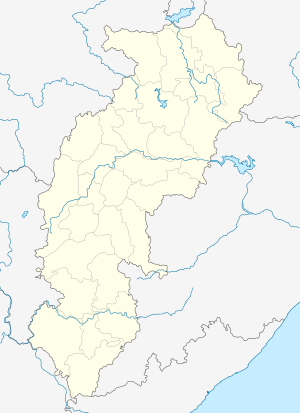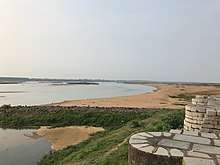Sirpur, Mahasamund
Sirpur is a village in Mahasamund district in the state of Chhattisgarh 35 km from Mahasamund city and 78 km away from Raipur[2] on the banks of the river Mahanadi.[3]
Sirpur Sripura, Shripura | |
|---|---|
village | |
 Hindu temples in Sirpur | |
 Sirpur Location in Chhattisgarh, India  Sirpur Sirpur (Chhattisgarh) | |
| Coordinates: 21.345225°N 82.184814°E | |
| Country | |
| State | Chhattisgarh |
| District | Mahasamund |
| Tehsil | Mahasamund |
| Government | |
| • Body | Village panchayat |
| Population (2011) | |
| • Total | 1,467[1] |
| Languages | |
| • Official | Hindi, Chhattisgarhi |
| Time zone | UTC+5:30 (IST) |
| Postal code | 493445 |
| Vehicle registration | CG 06 |
Sirpur was capital of Panduvanshi dynasty in ancient times. The village hosts the Sirpur Group of Monuments consisting of Buddhist, Hindu and Jain temples and monasteries. These are dated from the 5th to 12th century.
History


Sirpur, also referred to as Shripur, Sripura or Sripur (literally, "city of auspiciousness, abundance, Lakshmi") in ancient Indian texts and inscriptions, is a major archaeological site along the Mahanadi River.[4] Sirpur was capital of Panduvanshi dynasty in ancient times.
The site has been significant for its temple ruins of Rama and Lakshmana of the Ramayana fame, as well as those related to Shaivism, Shaktism, Buddhism and Jainism. The site excavations after 1950, particularly after 2003, have yielded 22 Shiva temples, 5 Vishnu temples, 10 Buddha Viharas, 3 Jain Viharas, a 6th/7th century market and snana-kund (bath house). The site shows extensive syncretism, where Buddhist and Jain statues or motifs intermingle with Shiva, Vishnu and Devi temples.[4]
The location is mentioned in the memoirs of the Chinese traveler Xuanzang as a location of monasteries and temples. It was visited in 1872 by Alexander Cunningham, a colonial British India official. His report on a Laxman (Lakshmana) temple at Sirpur brought it to international attention.
Culture
Sirpur is a pilgrimage site for the followers of Jainism, Buddhism and Hinduism. It hosts a major fair (mela) during the Mahashiv Ratri.
Transport
Sirpur is accessible from Raipur by a four-lane National Highway 53. Regular bus services connect Raipur and Sirpur.
The nearest railway station is Mahasamund railway station (35 km).
The nearest airport is the Swami Vivekananda airport at Raipur (IATA: RPR), with daily flights to major cities in India.
Places of interest
- Sirpur Group of Monuments
- Barnawapara, a nearby wildlife sanctuary set midst a hilly terrain and dense forests. The Indian bison gaur, cheetal, sambhar, neelgai and wild boar are found in this sanctuary.[5]
See also
- Sirpur Group of Monuments
References
- http://www.censusindia.gov.in/pca/SearchDetails.aspx?Id=469554
- Sirpur raipur.gov.in
- SIRPUR : A Goldmine of History Prasar Bharti
- Atula Kumar Pradhan and Shambhoonath Yadav (2013), Sirpur - A unique township of early medieval India, Proceedings of the Indian History Congress, Vol. 74 (2013), pp. 854-864
- "Archived copy" (PDF). Archived from the original (PDF) on 1 August 2014. Retrieved 6 August 2014.CS1 maint: archived copy as title (link)